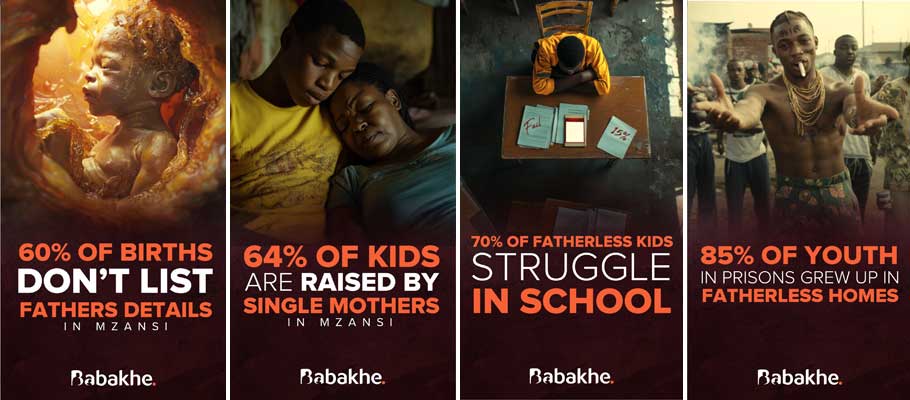
A view of Velemseni Njeke's exhibition Be a Father in Durban 2024
Through my exhibition “Be a Father”, I confront the critical issue of father absenteeism in South African townships, where 42% of children under 17 grow up without their fathers presence. The issue of father absenteeism is a global challenge that often relies on generic messaging and stock photography, creating a disconnect with target audiences. In developing this campaign, I aimed to change that approach by leveraging AI technology to create more authentic, culturally resonant content. During my research, I discovered that incorporating familiar visual cues and vernacular language significantly enhanced message effectiveness among target audiences. My work combines AI-generated imagery with emotional storytelling to explore the cyclical nature of absence and its profound impact on our communities.

At the heart of my exhibition is an infinite loop video, that talks about the journey of father absenteeism. I've created a visual narrative that follows a protagonist, distinguished by his yellow shirt throughout the scenes, as he navigates through moments of conflict, escape, and potential redemption. Using AI, I've crafted scenes that reflect authentic South African township experiences while maintaining universal emotional resonance, each frame building upon the story of choices and consequences.
This exhibition goes beyond simply documenting the issue - it aims to spark conversation and inspire change. Through storytelling and technology, I invite viewers to reflect on the cycle of father absence in our communities and their potential role in breaking it. My hope is that this work serves as both an emotional mirror and a catalyst for positive change in South African families.
PROCESS AND MY VIEW ON AI

I experimented with various AI engines to determine which would best suit my needs, discovering that each had its own unique strengths and weaknesses. I ultimately chose MidJourney because of its ability to generate highly realistic, high-resolution images that provided an excellent foundation for my work. Crucially, it excelled at depicting South African settings, which my research indicated was vital.
After developing my storyline and identifying the necessary scenes, I began the iterative prompting process in MidJourney. This required multiple refinements to achieve usable foundation images. Once I obtained suitable base images, I used Photoshop to adjust the mood and make necessary modifications to align with my project's vision. For example, one of my prompts was: "A realistic and intense scene of a black elderly man with grey hair standing over a shattered mirror on the floor in a modest room in a South African township. The man is wearing a worn yellow t-shirt, looking down at the broken mirror. Some of the mirror pieces reflect parts of his face, while other fragments show vivid memories: his wife smiling, his son playing alone. The atmosphere is heavy with emotion, the room dimly lit, and the broken glass scattered across the floor adds to the sense of sorrow and reflection. top view. The scene is filled with sadness and introspection. accents of gold and navy, environmental storytelling, lighting --v 6.1 --ar 16:9." (See the result below.)

The potential of AI extends far beyond this project, as it continues to transform various industries. AI technology enables campaigns like this to be adapted across different regions and cultures with targeted messaging, offering a cost-effective solution for scaling such campaigns without the need for expensive photo shoots and set production. Rather than viewing it as a replacement for human jobs, we should embrace it as a tool for creating more effective work.This was the core message I wanted to convey in this Visual Communication campaign – demonstrating how AI can be leveraged to amplify important messages that touch lives and heal communities

Sawubona, I am Velemseni Njeke, born and raised in KwaZulu-Natal, South Africa, where I spent my formative years in Richards Bay. My journey in graphic design began at the age of 14, sparking a passion that has shaped my creative path. Through years of freelancing, I've continuously expanded my understanding of design's potential and possibilities. My academic journey led me to the Durban University of Technology (DUT), where I earned my Diploma in Graphic Design, followed by an Honours degree. During my honours studies, I specialized in Artificial Intelligence, focusing on its meaningful applications for societal benefit. My research addressed the critical yet often overlooked issue of father absenteeism in South Africa, resulting in this portfolio and its associated projects. As a visual communicator, I strive to give voice to unspoken narratives through innovative design solutions. My goal is to continue pushing the boundaries of my knowledge and expertise, while using design as a powerful tool for social impact and storytelling.
